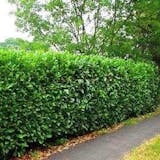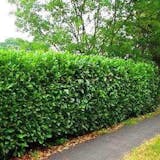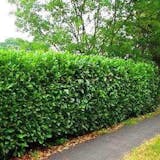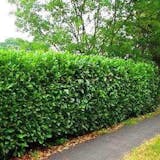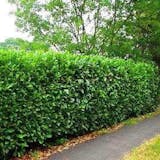




Product Details
Description
� Schip Laurel/Skip Laurel Shrub's Key Characteristics
Schip laurel (Prunus laurocerasus 'Schipkaensis') or Prunus Schipkaensis is a versatile evergreen shrub prized for its lush foliage, dense growth habit, and low maintenance requirements. Belonging to the Rosaceae family, this cultivar is commonly known as skip laurel or cherry laurel, and it is highly sought after for landscaping purposes.
Cherry laurel, Prunus laurocerasus, is very similar to the Skip laurel shrub. Usually, you can even find this type of cherry laurel plant in any schip laurel for sale. Schip laurel is also distinguished by its glossy, dark green leaves that are leathery in texture.
� Origin, Growing Conditions, and Optimal Habitat For Schip Laurel Plant
Skip laurel plant originates from the Balkan Peninsula in southeastern Europe. It is a cultivar of the cherry laurel (Prunus laurocerasus) species, which is native to regions spanning from Iran to the Mediterranean. The specific cultivar 'Schipkaensis' was developed for its compact growth habit and lush foliage, making it an ideal choice for landscaping purposes.
The growth habits of schip laurel contribute to its popularity in landscaping projects. It typically grows to a height of 6 to 10 feet tall, with a similar spread, though it can be pruned to maintain a desired size and shape. Its growth rate is relatively fast, allowing for rapid establishment and quick results in garden design.
For more information related to Schip laurel shrub, please refer to the table on the right.
✨Care and Maintenance of Cold Hardy Schipka Cherry Laurels
Schipka laurel is a hardy and low-maintenance evergreen shrub that adds beauty and structure to gardens and landscapes. To ensure its health and vitality, proper care and maintenance practices are essential. Below are guidelines for caring for and maintaining schip laurel:
- Planting Location: Choose a planting location that receives full sun to partial shade. Schip laurel is adaptable to various light conditions but thrives best with some sunlight. Ensure the soil is well-drained and fertile. Amend heavy clay soils with organic matter to improve drainage.
- Watering: Provide regular watering, especially during the establishment period after planting. Keep the soil consistently moist but not waterlogged. Once established, skip laurel is moderately drought-tolerant and requires less frequent watering. However, during prolonged dry spells, supplemental irrigation may be necessary.
- Mulching: Apply a layer of organic mulch, such as wood chips or bark, around the base of the plant. Mulching helps retain soil moisture, suppresses weeds, and regulates soil temperature.
- Pruning: Prune schip laurel in late winter or early spring to maintain its shape and size. Remove any dead, damaged, or diseased branches. Thin out overcrowded branches to improve air circulation and light penetration within the shrub. Avoid severe pruning, as skip laurel may not respond well to heavy pruning and may take time to recover.
- Fertilization: Apply a balanced fertilizer formulated for shrubs in early spring before new growth begins. Follow the manufacturer's recommendations for dosage and application. Avoid over-fertilization, as excessive nitrogen can lead to excessive vegetative growth at the expense of flowering and fruiting.
- Pest and Disease Management: Monitor schip laurel regularly for signs of pests such as aphids, scale insects, or leaf spot diseases. If pest or disease problems are detected, treat them promptly with appropriate horticultural oils, insecticidal soaps, or fungicides, following label instructions.
- Deer Protection: Schipka laurel is generally resistant to deer browsing, but young plants may be vulnerable. Consider using deer repellents or installing physical barriers, such as fencing, to protect vulnerable plants.
- Winter Protection: In regions with harsh winters, provide winter protection for skip laurel by applying a layer of mulch around the base of the plant and wrapping it with burlap or other protective material to shield it from cold winds and temperature fluctuations.
By following these care and maintenance practices, you can ensure the health, vigor, and longevity of schip laurel in your garden or orchard. With its lush foliage, dense growth habit, and low maintenance requirements, skip laurel remains an attractive and valuable addition to outdoor spaces.
�Searching for 'Where to Find Schip Laurels in Atlanta?'
When looking to purchase schip laurel for your gardening projects, it's essential to find a reputable supplier that offers high-quality plants and excellent customer service. At Pixies Gardens, we pride ourselves on providing top-notch schipka laurel specimens that will boost up the beauty of your outdoors.
At Pixies Gardens, we're passionate about providing premium skip laurel plants and exceptional service to our customers. Trust us to be your trusted partner in creating beautiful, thriving gardens.
� Frequently Asked Questions (FAQs)
1. What's the issue with schip laurels?
While schip laurels are generally hardy and low-maintenance, they can be susceptible to certain pests and diseases if not properly cared for. Common issues include scale insects, aphids, and leaf spot diseases. Regular monitoring and proper cultural practices, such as pruning and watering, can help prevent and manage these issues effectively.
2. Is it Schip or Skip Laurel?
The correct term for the cultivar is 'Schip laurel' (Prunus laurocerasus 'Schipkaensis'). However, it is also commonly referred to as 'skip laurel.' Both terms are used interchangeably in gardening and landscaping discussions and refer to the same plant.
3. How tall do schip laurel plants grow?
Schip laurel plants typically grow to a height of 6 to 10 feet tall, with a similar spread. However, the ultimate height can vary depending on factors such as growing conditions, pruning practices, and the specific cultivar.
4. Are skip laurels fast-growing shrubs?
Yes, skip laurels, including schip laurels, are considered relatively fast-growing shrubs. Under optimal growing conditions, they can exhibit vigorous growth, allowing for rapid establishment and quick results in landscaping projects.
5. What's the difference between a schip laurel and a cherry laurel?
While both Schip laurel (Prunus laurocerasus 'Schipkaensis') and cherry laurel (Prunus laurocerasus) belong to the same species, they are different cultivars. The main difference lies in their growth habits and characteristics. Schip laurel is known for its compact growth habit and dense foliage, making it id
Customer Service
Pixies Gardens
2024 Mcdaniel Mill Road Conyers GA 30094
Email: cs@pixiesgardens.com










